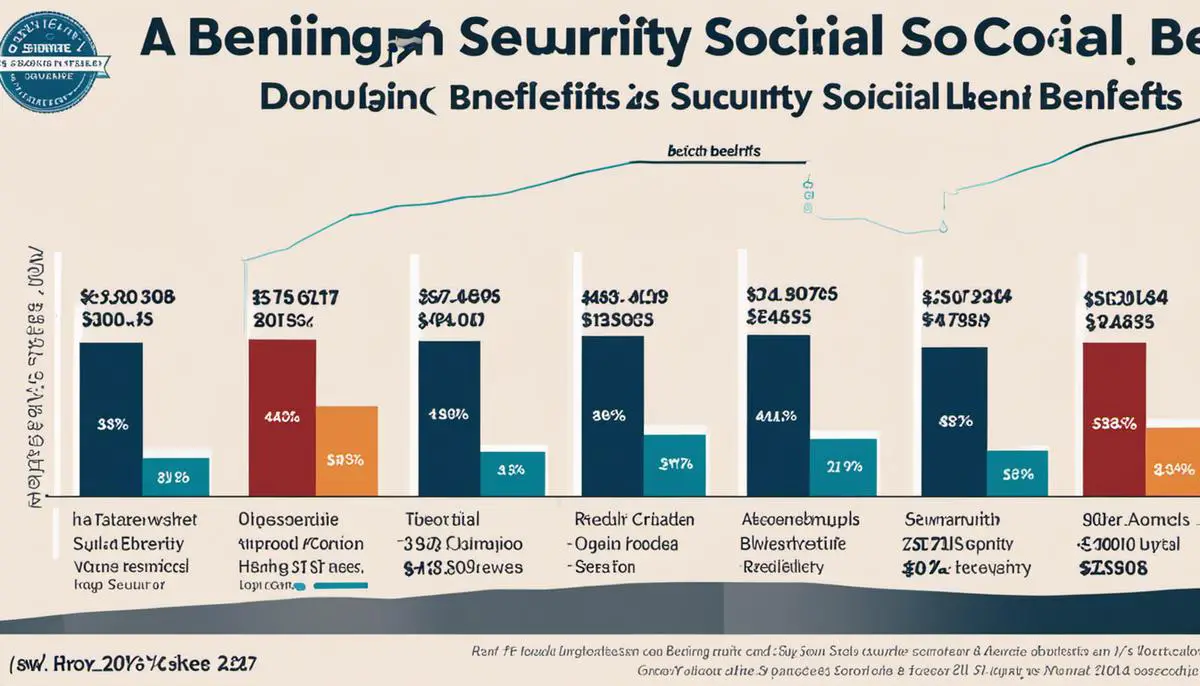Analyzing Social Security Benefits 2024: A Business Perspective
As we gaze into the future of Social Security Benefits in 2024, there is a multitude of crucial aspects that introduce potential modifications and effects to this vital lifeline for millions of American citizens. Our exploration commences by investigating the notable impact of demographic changes – factors such as increasing population and accelerating aging trends are poised to dramatically shape the dynamics of these benefits. The mirage of economic elements, ranging from inflation to employment rates, poses another layer of complexity to the outlook of benefits in 2024. Without dismissing the powerful sway of modifications to the eligibility criteria, we shall delve into the probability of regulatory alterations, their consequent potential effects on Social Security benefits, and how they may impact Americans in 2024.
Impact of Demographic Changes
Shaping the Future: A Deep Dive into How Demographic Shifts Influence 2024’s Social Security Benefits
In an era where the average American lifespan continues to extend, demographic shifts are reshaping our social and economic landscapes. One undeniable area where their impact is immediately seen, is in Social Security benefits, an integral part of many Americans’ retirement plans. Now, as we gaze into the horizon of 2024, it is becoming increasingly apparent how these demographic fluctuations could impact this crucial safety net for millions.
Firstly, let’s dissect the demographics. America’s populace is aging rapidly. The Census Bureau reports that by 2030, all baby boomers will be older than 65, effectively enlarging the size of the country’s older population. So, what’s the ripple effect on Social Security for 2024? More retirees tapping into Social Security equal less cash in the pool, plain and simple. There is no way around it; this larger group of beneficiaries will create immense pressure on the Social Security funds.
Simultaneously, we are seeing a decline in birth rates. According to the Centers for Disease Control and Prevention (CDC), birth rates in the US have hit a 35-year low. Fewer births point to a smaller workforce in the coming decades. With less revenue flowing into Social Security via payroll taxes, the expanding group of retirees will have less support, and the Social Security trust funds may deplete faster.
Considering these demographic shifts, alterations in Social Security benefits seem inevitable. Unless substantial adjustments are made, it is projected that the funding gap could lead to a reduction in benefits by 2024 for retirees. One possible adjustment could be increasing the retirement age; a difficult choice, but one that could potentially maintain the fund’s solvency.
However, it’s not all doom and gloom. The millennial generation and Generation Z are known for their passionate commitment to social causes, calling for system reforms and demonstrating entrepreneurial vigor that benefits society at large. Deploying intelligent strategies to make Social Security more efficient and sustainable could pull us back from the precipice.
For instance, perhaps it’s time to take a hard look at the payroll tax cap, which currently stands at $142,800. One must consider whether this cap meets today’s needs. A modest increase could generate additional revenue, thus supporting a financially healthier Social Security system. Alternatively, widespread adoption of digital technologies and more efficient data management could reduce administrative costs and, in turn, alleviate financial pressure.
In conclusion, demographic shifts are dictating a change in the Social Security landscape for 2024 and beyond. Our ability to navigate this change and come out successful will depend on policy adjustments, innovative strategies, and public-private partnerships. It’s a big ask, but with a can-do spirit and savvy decision-making, securing a solid future for Social Security amidst these demographic shifts is undoubtedly an achievable goal.

Economic Factors
Understanding the Economic Factors That Will Shape Social Security Benefits by 2024
Understanding economic intricacies presents opportunities to anticipate changes that will impact the American future significantly. Right now, it’s imperative to focus on key economic factors that will redefine Social Security benefits by 2024.- Firstly, economic growth rate and labor productivity play a significant role in delivering a solvent Social Security system. With a contracting economy or workforce productivity, the generated revenues may be insufficient to meet Social Security system obligations. Increased unemployment or underemployment will result in fewer people paying into the system, which could result in diminished reserves and smaller Social Security benefits. Therefore, stimulatory economic policies that improve the gross domestic product (GDP) and workforce productivity can strengthen the funding and sustainability of Social Security benefits.
- Secondly, societal variables such as inflation, wages, and consumer prices, significantly impact the Social Security system. Inflation types like wage inflation – growth in wages that outpaces the rise in the cost of living – stimulate the Social Security system because as wages increase, so do Social Security contributions. However, wage stagnation negatively affects contributions and henceforth, the system’s solvency. Simultaneously, the Consumer Price Index (CPI), which gauges inflation rates, dictates Social Security’s annual cost-of-living adjustments.
- The interest rate also plays a role. Social Security holds reserves in special issue U.S. government bonds. Hence, changes in the interest rate affect the income that Social Security derives from its assets. A higher interest rate signifies higher income from bonds, creating a stronger financial footing for the system.
- The fallout from the COVID-19 pandemic has brought a new economic factor into the mix – rising national debt. The increased government spending to support the economy has led to skyrocketing national debt. If managing this debt necessitates cuts to various government programs, Social Security may become a target, potentially transforming the benefits landscape significantly by 2024.
- The changing nature of work, particularly the rise in gig economy and automation, poses another potential challenge. A gig economy with many self-employed individuals who may not be contributing towards Social Security, combined with automation displacing human labor, could exacerbate the burden on the Social Security system.
- Finally, international trade affects Social Security through its impact on domestic industries. Trade imbalances that lead to job losses, particularly in sectors with high social security contributions, can unhinge the system’s equilibrium.

Analyzing Changes in the Eligibility Criteria
There’s a clear association between expected changes in eligibility criteria and amendments in Social Security benefits for 2024, reflected in various aspects of the economy and society. One key sector, for instance, is the economic growth rate and labor productivity. Growth in this area positively influences wage growth which boosts Social Security tax income, creating a stronger fund for future beneficiaries. However, sluggish labor productivity can temper this effect, demanding increased attention to policies that encourage innovation, entrepreneurship, and employee efficiency.
Among the factors that could seriously impact Social Security benefits is inflation, along with wage levels and consumer prices. These societal variables play a pivotal role in determining the annual cost-of-living adjustment (COLA) for Social Security, which safeguards the purchasing power of beneficiaries in a fluctuating economic environment. Thus, managing inflation and keeping a close eye on wage and consumer price trends is an essential part of any strategy aimed at securing the resilience of Social Security benefits in the face of potential eligibility changes.
Interest rates can weigh heavily on Social Security reserves; with low rates reducing income from the Treasury bonds in which these reserves are invested, potentially perpetuating the depletion of the Social Security trust fund. As the Federal Reserve continues to adjust rates in response to economic conditions, policymakers will need to play a deft hand in decision-making to ensure the Social Security system remains robust.
The spectacular rise of the national debt could pose a challenge for Social Security benefits; as government resources are stretched thin, there’s a risk of diverting funds away from Social Security toward other expenses, impacting the fiscal health of the program. As entitlement reform and strategies for debt stabilization shape up as political flashpoints, the dialogue must incorporate the future of Social Security amidst these potential challenges.
The changing nature of work – from the rise of the gig economy and automation to globalization – has profound implications for Social Security. Workers in non-traditional jobs often lack the employer-sponsored retirement benefits available in traditional full-time positions, leading to a greater reliance on Social Security in retirement. Measures must be initiated that capture taxes from the modern forms of employment to fund Social Security adequately.
Lastly, the impact of international trade on domestic industries can have downstream effects on Social Security. Trade policies that result in job losses or wage stagnation can lessen the inflow of payroll taxes to the Social Security fund. Policymakers aiming for sustainable Social Security benefits need to negotiate this terrain with a keen focus on maintaining domestic economic stability.
Projected changes in Social Security eligibility criteria for 2024 are certainly shaping up as a key issue demanding strategic, innovative responses. Rest assured, with careful management and forward-thinking strategies, the prospects of a robust Social Security system catering to the needs of future retirees remains a possibility.

Fiscal Sustainability
Diving into nuances, one primary aspect we need to acknowledge is the influence eligibility criteria changes can have on Social Security benefits in the year 2024. At stake is the vulnerability of millions who rely on these benefits, arduously tied to rankings of disability, retirement age thresholds, and income levels. Amendments in these standards encode shifts in the Social Security landscape, and in the benefits doled out.
Next, we grapple with the economic growth rate and labor productivity. As these indicators fluctuate, they have a potent influence on the Social Security system’s solvency. Higher growth rates and productivity mean better wage income, which boosts Social Security payroll tax revenue. Conversely, sluggish growth and unproductive labor markets could hamper Social Security’s ability to meet its commitments.
We cannot overlook the impact societal variables like inflation, wage levels, and consumer prices have on Social Security benefits. These variables directly affect the adjustment of benefits and create a rippling effect on recipients’ purchasing power. As such, policymakers should be vigilant in considering these variables when crafting regulations for Social Security benefit calculations.
Interest rates, in their own stead, have a sweeping influence on Social Security reserves. Higher interest rates bode well for the Treasury bonds in which the Social Security trust funds are invested, amplifying income from interest. However, lower interest rates can stifle growth of the reserves, straining the system’s long-term fiscal health.
There’s an elephant in the room that we can no longer ignore – the rising national debt. As it escalates, it’s likely to squeeze resources available for Social Security. The squeezing could translate into an ugly potential ramifications for benefits, in the likelihood of drastic reductions to counterbalance budget shortfalls.
A sweeping change casts a shadow over the future of Social Security – the shifting nature of work. With the rise of the gig economy and automation, there’s a pressing need to reevaluate who is covered by Social Security. As workers shift from traditional employment to gig or contract jobs, they fall outside of the Social Security net, posing severe challenges to the program’s sustainability.
Lastly, we cannot discount the impact of international trade on Social Security. As globalization carves alterations into domestic industries, it influences the composition of the workforce, and consequently, the flow of payroll taxes into the Social Security system.
In conclusion, the leveraging of fiscal sustainability as a linchpin in the future of Social Security benefits and its resultant implications highlight the need to turn diligent eyes and innovative minds to the drawing board. As each element interweaves and interacts, it forms the lattice upon which the promise of Social Security hangs. Gazing ahead at 2024, these insights offer a potent lens to realign strategies and steer the ship of Social Security towards a sustainable horizon.

Impact on Various Sectors
Diving deeper into these primary issues, industrial sectors will experience varying impacts as Social Security undergoes this transformation. After all, these changes take place against a backdrop of constant innovation, upskilling requirements, and the need for industries to be proactive rather than reactive.
Healthcare, housing, and the financial sector could face significant changes. With older Americans forming a large chunk of the clientele, reductions in Social Security benefits may curtail consumer spending, thus affecting their bottom line. Retirement-based industries like senior housing developments, assisted living providers, and home healthcare services will need to brace for a possible decline in demand if retirees have less disposable income.
In the technology industry, we have the controversial but inevitable reality of automation. Amid its potential to thin out the workforce, one consequence of increased automation could be a decrease in Social Security contributions, constraining the resources to be disbursed among beneficiaries.
The gig economy will see alterations, too. Presently, self-employed individuals shoulder the entire responsibility of Social Security tax. Should Social Security reforms raise the cap on taxable earnings, gig workers earning higher incomes may need to contribute more, creating potential angst within this innovative workforce subset.
Another significant trend can be noticed in the retail sector. The transition towards e-commerce has paved the way for the global distribution of goods. However, an influx of imported goods can impact domestic manufacturing jobs, many of which contribute significantly to Social Security through payroll taxes.
Lastly, the finance industry may grapple with a potential increase in pressure. As retirement savings might not suffice in the face of decreased Social Security benefits, individuals might diversify their investments. This shift could lead to an upswing in demand for financial services but also a greater need for robust, ethical advice to navigate the changing landscape.
Therefore, market players across sectors must prepare for these shocks and adapt their strategies to mitigate the impacts of changes in Social Security. Robust change management, fortified by innovations, can drive the industry to foster resilience amidst the evolving game rules. In the realm of entrepreneurial genius, these changes are not seen as a burden, but as a stepping-stone towards the next big opportunity to fill a market need.

Photo by mannydream on Unsplash
With a robust critique of the fiscal sustainability of the Social Security system, our analysis also addresses the sustainability and feasibility of this system as we approach 2024. Scrutinizing crucial financial components such as deficits, budgets and funding, it’s clear that the fiscal underpinnings of Social Security bear a significant weight on its operation. Of course, any changes to these benefits also ripple out to influence major sectors – healthcare, real estate, and the vast retirement sector to name a few. Thus, it’s evident that the Social Security benefits of 2024 will wield a significant impact not only on individuals but across various sectors and the broader economy as a whole, underscoring the urgent need for comprehensive understanding and farsighted policymaking.



Leave a Reply